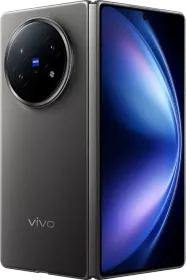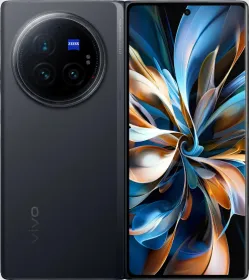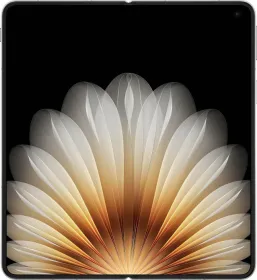This is actually my first time using a foldable device, and I was excited that I got the opportunity to test the vivo X Fold5. And I have to say, I’m impressed, especially with the battery life and the form factor. I genuinely love how natural this foldable feels in my hand. It just works like a regular phone, and then out of nowhere, you can open it up into a full-fledged large screen whenever you want to.
The 6,000 mAh battery here is massive and gives the kind of endurance you rarely see even on normal flagships. And with IP5X, IPX8, and IPX9+ dust and water resistance, this is easily one of the most durable foldables on the market.
You’ve got strong display protection, a solid hinge mechanism, high-quality dual displays, fast wired and wireless charging, and a surprisingly good set of cameras, including a proper 3X telephoto with macro support and a large main sensor. That’s something you don’t usually get in this category.
So, let’s get into everything about the vivo X Fold5 in this review (in detail), from design and display to performance, cameras, and more.
vivo X Fold5 Price & Availability
The vivo X Fold5 is available in India in a single variant with 16GB LPDDR5X RAM and 512GB UFS 4.0 storage for ₹1,49,999. It’s available in Titanium Grey, and ships with a case inside the box. The case covers the hinge and back, but unfortunately, not the right edge. You can purchase it via Amazon, Flipkart, vivo’s official site, and other offline retailers.
Pros
- Slim and lightweight foldable; feels like a normal phone in the hand
- 6,000 mAh battery actually delivers
- 90W wired + 40W wireless charging is a great combo
- Durable hinge, IP58 & IP59+ rating
- Excellent AMOLED displays (both inside and outside)
- Rear cameras are very good for a foldable
- AI and productivity tools that are actually useful
Cons
- Front cameras are weak (both cover and inner)
- Software still feels a bit clunky and dated
- Shortcut button placement is too high
- Some UI bugs and app scaling issues on the foldable display
vivo X Fold5 Specifications
- Main Display: 8.03-inch 2K+ AMOLED, 120Hz LTPO, 4500 nits peak
- Cover Display: 6.53-inch AMOLED, 120Hz, 4500 nits peak
- Chipset: Snapdragon 8 Gen 3
- RAM: 16GB LPDDR5X
- Storage: 512GB UFS 4.0
- Rear Cameras:
- 50MP Main Sony IMX921 1/1.56-inch, 23mm, OIS, f/1.57, AF
- 50MP Ultra-wide Samsung JN1 1/2.75-inch, f/2.05, AF
- 50MP Telephpoto Sony IMX882 1/1.95-inch, f/2.55, 3X optical, OIS, AF 15cm macro
- Front Cameras:
- 20MP (cover, f/2.4, fixed focus, OV32D 1/3.6-inch cropped to 1/4.6-inch)
- 20MP (inner screen, f/2.4, fixed focus, OV32D 1/3.6-inch cropped to 1/4.6-inch)
- Battery: 6000 mAh
- Charging: 90W wired, 40W wireless
- IP Rating: IP59+, IP58
- Software: Funtouch OS on Android 15
- Biometrics: Side-mounted fingerprint
- Weight: ~217g
- Thickness: 4.3mm (unfolded), 9.2mm (folded)
vivo X Fold5 Review: Design and Build

The moment I picked up the X Fold5, it didn’t feel like a foldable. It genuinely just felt like a normal phone – slim, lightweight, and well-balanced. At 4.3mm unfolded, this is one of the thinnest foldables out there, and even when it’s folded, it doesn’t feel bulky. Most people I handed it to didn’t even realize it was a foldable until they opened it.

The hinge feels strong and smooth, and the crease is barely noticeable when you’re looking at it from the front. That said, the Z Flip7 that I got recently has a less noticeable crease. I also tried the Z Fold7, and it’s safe to say that it has a less noticeable crease too. You get water and dust protection, IPX9+, IPX8, and IP5X, which is a big deal. This is perhaps the best IP rating on any foldable smartphone.
There’s also a Shortcut button on the side, but honestly, it’s placed so high that I just didn’t use it. To give you some perspective, it’s placed right below the status bar/punch hole. You can customize it for a long press and/or double press, which is nice.

The USB-C port also has a slight curve to it, which might look odd, but I assume it’s designed that way to fit the curved edges.

The vivo X Fold5 is also the second lightest book-style foldable on the market, weighing just 217g, only slightly heavier than the Galaxy Z Fold7 at 215g. And trust me, it doesn’t feel bulky at all. Overall, the X Fold5 feels solid in hand and is crafted from premium materials. vivo has done an excellent job with both the design and build quality.
vivo X Fold5 Review: Display

Both displays here are excellent. The cover screen is 6.53 inches and feels like a regular phone display—bright, smooth, and very usable. The inner display is 8.03 inches and opens up to a proper tablet-sized screen.
Both use AMOLED panels, hit up to 4500 Nits of peak brightness (no issues using outdoors or even in the sun), and support 120Hz refresh rates. The punch-hole camera on the inside is in the corner, which is a nice touch.

Using the phone outdoors was never a problem as both screens are super bright. PWM dimming is also handled well on the cover screen. I used the phone for long hours and didn’t feel any eye strain. Notably, the inner screen gets smudged up very quickly and it’s something that I really don’t like about it.
You’ll need to turn on app continuity manually in settings if you want seamless switching between screens. It mostly works fine, but yeah, some apps still don’t adapt properly when moving from the outer display to the inner one. That’s something vivo needs to fix.
vivo X Fold5 Review: Speakers and Haptics
The speakers are really good. There’s stereo separation, the volume gets loud without distorting, and content sounds full and clear. You also get an array of microphones for better audio pickup during calls and recordings.
Haptics are also good on the vivo X Fold5. They’re not as strong as some other phones that I’ve tested, but they are fine. However, I feel like vivo could’ve done a better job with the haptics integration in the software.
vivo X Fold5 Review: Software

Now let’s talk about software, because this is where vivo is doing a lot of interesting things, even if Funtouch OS still feels a bit outdated visually.
First up, let’s talk about the AI features, because vivo has genuinely packed in a lot here, and surprisingly, most of them are useful.
You get the AI Image Expander, which lets you literally zoom out of a photo and the phone intelligently fills in the rest of the background. It’s actually fun to use and works well. Then there’s AI Magic Move, which lets you move objects within a photo, and refill the image.


There’s also the AI Erase 2.0, which removes unwanted objects from photos and it does a pretty good job. You also have Reflection Remover, which helps if you’ve taken a photo through glass, and Photo Enhance, which boosts brightness, saturation, and detail using AI.


Then there’s Live Text, which lets you select text from any image in the Albums app and instantly copy it. Similarly, you can tap and hold a subject to instantly separate it from the background and copy or save it as a new image.

vivo has also added AI Call Summaries, and this is impressive. If you’re on a call, it can transcribe the conversation and summarize it into neat bullet points afterward. And this works in Hindi, English, and a few other languages too. These summaries are saved to the Notes app, where you can access more AI features like Smart Layout, Summarize, Extract to-dos and Translate.


The AI Meeting Assistant is similar, you can use it during video calls or WhatsApp voice chats, and it’ll transcribe and summarize key points. You’ve also got vivo Docs, which lets you open and edit documents directly on the phone, and it even converts images to PDF or Word with AI. Unfortunately, both AI Meeting Assistant and vivo Docs are currently not available and will be rolled out via an OTA update later.

DocMaster can only be accessed by opening a document and selecting Open With > vivo DocMaster. From there, you choose either Open and Save or Open Only. Once inside, you can convert the file to PDF, PPT, image, or long image, search within it, save it separately, or annotate with tools like signature, shapes, text, pen, highlighter, and eraser. It’s a useful feature, but the lack of a dedicated app icon makes it harder to find and use.

And for multitasking, you have the Origin Workbench. It’s vivo’s version of a desktop-style environment, similar to Apple’s Stage Manager. And since this is a foldable device, you can also open multiple floating windows, drag and snap them, and use the taskbar at the bottom to switch between apps. If you half-fold the phone, it automatically switches to Flex Touchpad mode, so you can scroll and tap like you’re using a laptop.


There’s also Smart Screen Shift, which detects if the phone is in tent mode or half-folded and shifts content to the correct screen automatically. It’s super convenient for watching videos or checking messages hands-free.
But yeah, not everything is perfect. There are still bugs. Sometimes apps don’t scale properly when switching between screens. Sometimes UI elements don’t behave like they should. It’s definitely better than it used to be, but Funtouch OS still needs more polish, especially on a foldable like this.

Oh, and if you wish, you can select the default aspect ratio of apps on the cover screen (Settings > Foldable devices > Main screen app display ratio). However, this will cause issues when switching between the cover and the inner screens. vivo has promised 4 years of OS and 5 years of security updates for the X Fold5.
vivo X Fold5 Review: Biometrics
The fingerprint scanner is side-mounted, not under-display like the previous model. But honestly, I didn’t mind. It’s quick, consistent, and works whether the phone is folded or unfolded. Face unlock is available too, but I wouldn’t rely on it for anything secure.
vivo X Fold5 Review: Performance

The vivo X Fold5 uses the Snapdragon 8 Gen 3, not the new 8 Elite, but that’s totally fine. This chip is more than powerful enough for everything. Apps open quickly, games run smooth, and multitasking is no issue. You also have 16GB RAM and 512GB UFS 4.0 storage, so there’s plenty of headroom for anything you want to do.
Synthetic Benchmarks:
- AnTuTu v10: 1,819,397
- Geekbench 6 (CPU): Single-Core: 2,157; Multi-Core: 6,321
- Geekbench 6 (GPU): OpenCL: 14,470; Vulkan: 16,249
- AnTuTu v10 Storage Test:
- 3DMark Wild Life Extreme Test: Best Loop: 3,263; Lowest Loop: 2,098; Stability: 64.3%

Gaming-wise, BGMI runs at 90 FPS, Genshin Impact stays around 60 FPS on Highest settings, and I didn’t face any overheating issues. That’s probably thanks to the vapor chamber cooling system inside. It really helps maintain stable temps. Even in day-to-day use, the phone feels snappy and does not overheat despite being so thin.
vivo X Fold5 Review: Cameras

The rear cameras on the X Fold5 are great, and not just for a foldable. The main 50MP IMX921 captures sharp and well-balanced shots. HDR is strong, colors are punchy but natural, and the dynamic range is solid. You also get ZEISS filters like Natural, Texture, Vivid, and the new Classic Negative, with Blue Film and Positive Film coming soon.
The ultra-wide is okay, nothing amazing, but gets the job done. There’s some chromatic aberration, especially around the edges, but detail is good and even in low light it performs decently.








Now the 3X telephoto. This is the best part of the camera setup. It’s using the IMX882 sensor and supports macro shots with a 15cm focusing distance. It’s sharp, detailed, and the macro capabilities are surprisingly good.
You also get vivo’s multifocal portrait presets at 23mm, 35mm, 50mm, 85mm, and 100mm, all of which can be paired with the ZEISS bokeh styles like Biotar, Sonnar, Planar, Distagon, etc.






Processing can be a bit too much at times, but you can customize everything from brightness to contrast and saturation.
You also get Supermoon mode, Stage mode, and even Dual Preview—the subject can also see the image preview on the cover screen. Pro Mode is available for both photos and videos. Portrait video, though, is limited to 1080p 30fps, which is a bit of a letdown.
The Snapshot mode is now directly integrated into the Photo mode, allowing you to freeze moments but the focal lengths are still limited to 1X, 2X, and 3X, no in-between too.
The front cameras are the only real weak point here. Both the inner and cover display cameras are 20MP OV32D sensors, and neither performs well, in daylight or low light. After doing some digging, I found that vivo is actually cropping the 32MP OV32D sensor from 32MP 1/3.6 inches to 20MP 1/4.6 inches for some reason.



Your best bet is using the rear camera for selfies. There’s a Rear HD Selfie option, and it works, but the phone gets awkward to hold, and you can only use the main and ultra-wide lenses. You can also take videos this way and the quality from the main camera is actually good. However, I do feel that vivo needs to improve on the EIS stabilization a bit.



Overall, with the vivo X Fold5, you’re getting a really good camera setup with ZEISS imaging and T* coating (for reducing glare and reflections). The zoom camera on this is probably the best you can get on a foldable today. That said, I’d like to see a better selfie camera in the next iteration.
vivo X Fold5 Review: Battery Life and Charging

Battery life is easily one of the strongest points here. I was consistently getting over 10 hours of screen-on time. I’d use the inner display for about 1 to 2 hours, and the rest on the cover screen, and it easily lasted a full day with moderate to heavy use.
Charging is quick too. The 90W wired charger takes it from 1 to 100% in just under an hour, and the 40W wireless charging is super convenient, especially for a foldable. There are no major heating issues during charging either.
Review Verdict: Should You Buy the vivo X Fold5?
For my first foldable experience, the vivo X Fold5 honestly surprised me. It’s lightweight, has amazing battery life, and packed with good cameras, smart AI features, and one of the most durable designs out there. It still has a few issues, like the weak front cameras, outdated software design, and the shortcut button placement, but most of them aren’t deal-breakers.
If you’re looking for a foldable that has great cameras and battery life, the X Fold5 comes very close. It’s one of the best foldables you can buy right now in 2025, especially if you value battery life, durability, rear camera quality, and actual productivity features that go beyond just multitasking. The launch price is ₹1,49,999, but you get an instant ₹15,000 discount on pre-booking, which makes it a decent offer. Still, I’d recommend waiting for a better deal, ideally around ₹1,25,000, for the best value.

Smartprix ⭐ Rating: 8.5/10
- Design and Build: 8.5/10
- Display: 8.5/10
- Speakers & Haptics: 8/10
- Software: 8/10
- Biometrics: 8.5/10
- Performance: 8.5/10
- Cameras: 8.5/10
- Battery Life & Charging: 9.2/10
First reviewed in July 2025.





































































































